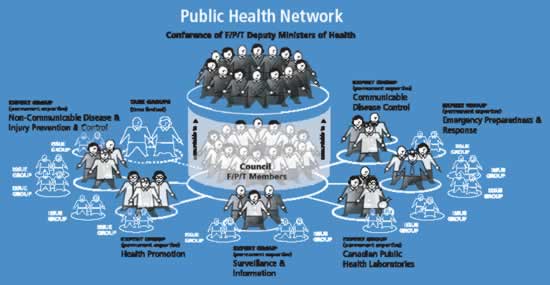Common menu bar links
Institutional links
Diseases & Conditions
Health & Safety
Research & Statistics
Agency Information
Search Box
E-mail this page
Partners in Public Health - Summary Report
Why the Pan-Canadian Public Health Network?
The Public Health Network will ensure that Canada is better prepared for future public health events by:
- fostering cooperative and collaborative approaches on public health matters;
- establishing, maintaining and implementing instruments, initially in the form of collaborative public health strategies, formal inter-jurisdictional arrangements (with the Agreement on Mutual Aid During an Emergency, as identified below, as the first of these), and a framework for a common approach to public health legislation and regulation;
- facilitating collaboration and mutual aid across jurisdictions during public health crises and urgent situations;
- establishing consensus-based priorities helping governments focus and refi ne their public health investments and resources;
- encouraging processes for developing, implementing, maintaining and updating standards, guidelines, and best practices in the public health field;
- negotiating arrangements which will govern intergovernmental collaboration in the day-to-day business of public health;
- facilitating processes whereby applied research can be best translated into policies, programs and practice; and,
- developing strong and robust public health partnerships between governments, academics, researchers, non-government organizations and health professionals.
More specifi cally the Network will be mandated to:
- facilitate information sharing among all jurisdictions;
- disseminate information regarding best-practices in public health;
- support the public health challenges jurisdictions face during emergencies;
- provide advice and regular reporting to F/P/T Deputy Ministers of Health on public health matters and the activities of the Network;
- collaborate on the day-to-day operations of public health;
- respect jurisdictional responsibilities in public health; and,
- be accountable to the Conference of federal/provincial/territorial (F/P/T) Deputy Ministers of Health.
In undertaking its work, the Public Health Network will:
- respect the authority and jurisdiction of each government to manage public health operations within their own domain;
- embrace the differences in how each jurisdiction exercises its public health responsibilities, establishes priorities and manages its public health infrastructure;
- recognize that there is no 'one size fi ts all' approach to public health; and,
- include as part of the scope of the Network's activities collaboration with, and participation of, non-governmental organizations, researchers, academics and other public health experts.
As demonstrated in the governance of the Public Health Network, as illustrated on the following page, the Public Health Network (through its Council) is responsible and accountable to the F/P/T Conference of Deputy Ministers of Health. The Conference of Deputy Ministers of Health will provide the Council with its mandate, role, initial set of priorities and will hold the members on the Council accountable for the deliverables and performance of the Network. The Council will be co-chaired by the Chief Public Health Officer of Canada (on behalf of the Government of Canada), and a provincial/territorial member, serving as the co-chair on a rotational basis.

The vast majority of the work of the Network will be executed through an initial series of six Expert Groups on the following public health issues:
- Communicable Disease Control;
- Emergency Preparedness and Response;
- Canadian Public Health Laboratories;
- Surveillance and Information;
- Non-Communicable Disease & Injury Prevention & Control; and,
- Health Promotion.
The Expert Groups will manage collaborative processes and consist of members who will voluntarily work together to share information, expertise, and best practices. Moreover, as the Network is designed to streamline and enhance linkages and functional relationships on public health matters, all current interjurisdictional collaborative committees and groups will be integrated into the Network.
The Council may also create project-oriented Task Groups to assist and advise on emerging issues or to undertake specifi c work when an existing Expert Group is not appropriate. (See Sections 3-5 of the Main report for details and Annex B for the Terms of Reference for the Council).
[Back] [Table of Contents] [Next]
